Awards and decorations of Nazi Germany were military, political, and civilian decorations that were bestowed between 1923 and 1945, first by the Nazi Party and later the state of Nazi Germany.
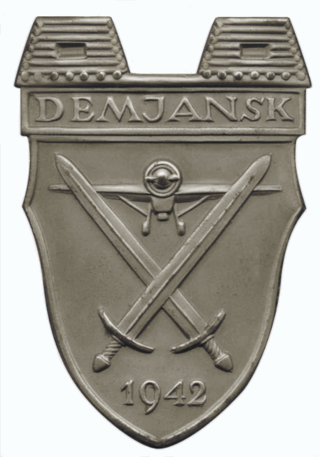
Demyansk Shield was a World War II German military decoration awarded to Wehrmacht personnel who fought in the Demyansk pocket on the Eastern Front in the early months of 1942. The pocket of German troops had been encircled and cut off by the Red Army around Demyansk (Demjansk), south of Leningrad, and was successfully defended with the aid of an airbridge. The shield was instituted on 25 April 1943 by Adolf Hitler and was not bestowed after 1 July 1944.

The Kuban Shield was a World War II military decoration of Nazi Germany. It was awarded to Wehrmacht forces who fought at the Kuban bridgehead in the Soviet Union from February 1943 until it was abandoned in October 1943. The award was instituted on 21 September 1943.
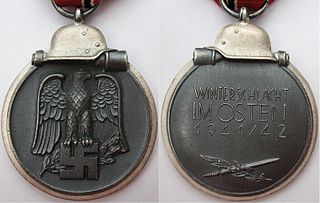
The Eastern Medal, officially the Winter Battle in the East 1941–42 Medal, was a military award of the Wehrmacht which was created by ordinance of Adolf Hitler on 26 May 1942.
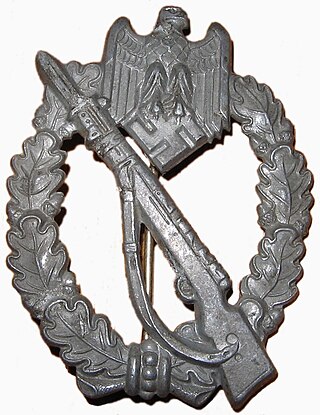
The Infantry Assault Badge was a German military decoration awarded to Waffen-SS and Wehrmacht Heer soldiers during the Second World War. This decoration was instituted on 20 December 1939 by the Commander-in-Chief (Oberbefehlshaber) of the German Army, Generalfeldmarschall Walther von Brauchitsch. It could be awarded to members of infantry and Gebirgsjäger units that had participated in infantry assaults, with light infantry weapons, on at least three separate days of battle in the front line on or after 1 January 1940. When a counter-offensive led to fighting, it could also apply. Award of the Infantry Assault Badge was authorized at regimental command level, and mechanized or motorized infantry were not eligible for the original badge. A bronze variant of the Infantry Assault Badge was created in June 1940, authorized for motorized and mechanized infantry units, using similar requirements for award as the original silver variant. Non-infantry personnel were not eligible for either grade of the Infantry Assault Badge, but were eligible for other combat recognition badges, usually the General Assault Badge, Close Combat Clasp, or the Panzer Badge. The Luftwaffe would develop its own ground combat badge in 1942, the Ground Assault Badge.

The Close Combat Clasp was a World War II German military award instituted on 25 November 1942 for participation in hand-to-hand fighting at close quarters. Intended primarily for infantry, other Wehrmacht, Waffen-SS, ground Luftwaffe units and paratroopers were also eligible.
The Danzig Cross was a Nazi decoration of the Free City of Danzig. The Cross was instituted on 31 August 1939 as a two grade decoration by Danzig Gauleiter Albert Forster. It was awarded to those, both in Danzig and in the wider Reich, who contributed to building up the Nazi Party in the Free City prior to its incorporation into Germany on 1 September 1939.

The Panzer Badge was a World War II military decoration of Nazi Germany awarded to troops in armoured divisions. Before 1 June 1940 it was known as the Panzerkampfwagenabzeichen.

The Crimea Shield was a World War II German military decoration. It was awarded to military personnel under the command of Field Marshal von Manstein, including supporting naval and air force units, who fought against Soviet Red Army forces between 21 September 1941 and 4 July 1942 and who captured the Crimea region. It was instituted on 25 July 1942. It was the most widely distributed of the various German campaign shields, with approximately 250,000 awarded.
The Honour Roll Clasp was a decoration of Nazi Germany during World War II. There were different versions for the Army (Heer), Air Force (Luftwaffe) and Navy (Kriegsmarine).
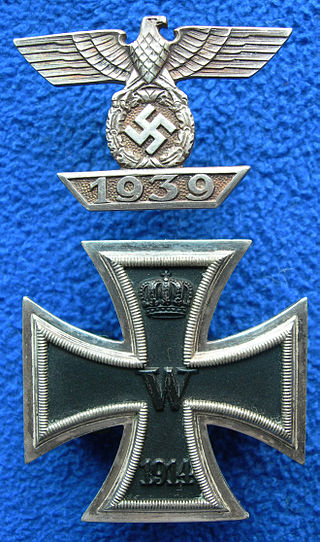
The Clasp to the Iron Cross was a white metal medal clasp displayed on the uniforms of German Wehrmacht personnel who had been awarded the Iron Cross in World War I, and who again qualified for the decoration in World War II.
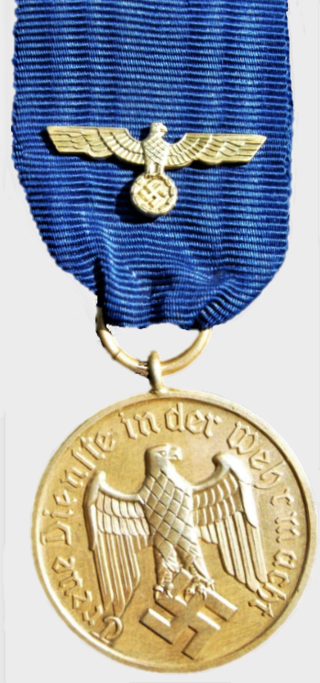
The Wehrmacht Long Service Award was a military service decoration of Nazi Germany issued for satisfactory completion of a number of years in military service.
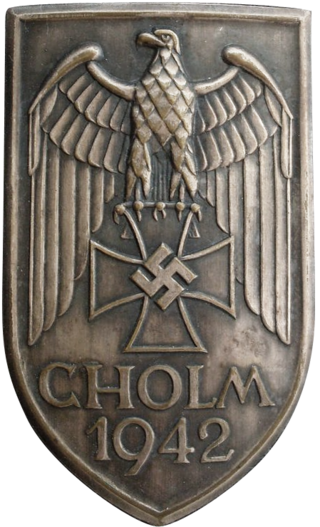
The Cholm Shield was a World War II German military decoration awarded to those who fought in the Cholm Pocket on the Eastern Front between 21 January and 5 May 1942. It was instituted on 1 July 1942 and is the rarest of the German combat shields, with approximately 5,500 recipients. Awards ceased to be bestowed on 1 April 1943.
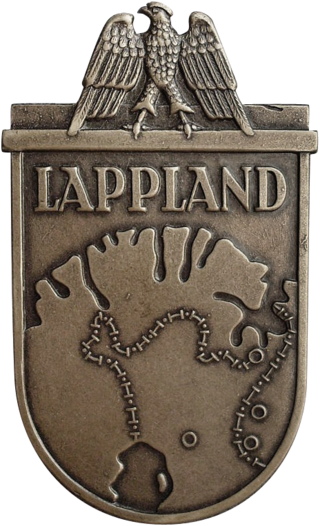
The Lapland Shield was a World War II German military decoration awarded to military personnel of General Franz Böhme’s 20th Mountain Army which fought a two-front campaign against advancing Finnish and Soviet Red Army forces in Lapland between November 1944 and the war’s end in May 1945. It was awarded to men who had "honorably served" for six months in the region or had been wounded during operations there. It was authorized in February 1945 and was the last officially instituted German campaign shield of the war.
Campaign shields, also known as campaign arm shields, were badges of differing design awarded to members of the German Wehrmacht for participation in specific battles or campaigns during World War II. Each shield was worn on the left upper arm of the uniform jacket. If a recipient received more than one shield, the earlier was worn above any later awards.

The Crete Cuff Title, or Crete Cuff Band, was a World War II German military decoration awarded to Wehrmacht servicemen who took part in the battle of Crete between 20 and 27 May 1941.

The Africa Cuff Title, or Africa Cuff Band, was a World War II German military decoration awarded to members of the Wehrmacht who took part in the North African campaign of 1941–43.
The Metz 1944 Cuff Title, or Metz 1944 Cuff Band, was a World War II German military decoration instituted to reward members of the Wehrmacht who took part in the 1944 battle of Metz.

The Courland Cuff Title, or Courland Cuff Band, was a World War II German military decoration awarded to Wehrmacht servicemen of Army Group Courland who served in the Courland Pocket.

The Warsaw Shield,, or Warsaw Arm Shield, was a planned World War II German military decoration intended for award to Wehrmacht and Waffen-SS servicemen who took part in the suppression of the 1944 Warsaw uprising. Although authorised, with the conditions of award and the design approved and announced, production had not begun prior to the end of the war and the award was never issued.
















